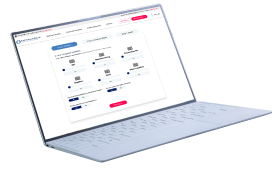
Understand your company's position and learn more about the options available
Require Immediate Support? Free Director Helpline: 0800 644 6080
Free Director Helpline: 0800 644 6080
Published:
If your company has debts it cannot pay, liquidation is not a foregone conclusion. We have rescued hundreds of UK companies and helped them repay or restructure their debts so they can continue trading. If your company is insolvent, you must contact Insolvency Practitioners like the team at Real Business Rescue at your earliest opportunity. That will give us the best chance of saving your company and increase the options available.
Liquidation is the process of closing a limited company and selling its assets to repay its creditors (parties it owes money to) as far as possible. Any debts the liquidator cannot repay from the sale of assets will be written off, and the business will be struck from the official register at Companies House and cease to exist.
There are different ways your company can enter liquidation. You can liquidate it voluntarily using a process called Creditors’ Voluntary Liquidation (CVL) if it cannot pay its debts when they are due and there’s no realistic prospect of a recovery.
Alternatively, a creditor can force you into Compulsory Liquidation if it believes liquidation is the best way to recover the outstanding debt. Compulsory Liquidation carries a greater risk of adverse legal and financial consequences for the company’s directors. That’s why it’s usually preferable to enter liquidation voluntarily.
Several strategies could help to keep the company afloat if you believe your business is still viable and could return to profitability.
It might sound overly simplistic, but streamlining the company and reducing its overheads could free up the working capital you need to clear priority debts and get back on track.
Companies often diversify as they grow, potentially creating unprofitable parts of the business that drain cash from other areas. Streamlining the business by refocusing on its core, proven areas could improve cash flow and increase profitability.
Cutting back on non-essential expenses, such as marketing, entertainment and travel, could also provide a quick profitability boost. However, you should avoid cuts that could harm your revenue or productivity. It may also be possible to reduce overheads such as rent and utilities, for example, by moving to a smaller office or subletting unused floor space to a third party.
When your company is struggling, traditional forms of finance like bank loans might be out of reach, and you may already be at the maximum limit of an overdraft facility. However, there are alternative funding options that could increase your cash flow.
If you sell business to business, invoice finance allows you to release the value in the invoices you send to your clients. You can access up to 90% of the value of an invoice within 48 hours of issuing it to a customer. You then receive the balance of the invoice when the customer makes the payment, minus the finance provider’s fee. Unlike traditional debt financing, there are no monthly debt repayments to worry about, although you may have to provide a personal guarantee.
If you sell directly to consumers, merchant cash advances enable you to access a lump sum payment that you repay through a percentage of your future debit and credit card sales. That can free up the cash flow you need to repay creditors like suppliers and HMRC.
Another option is asset finance. If your business has valuable assets, such as property, machinery or vehicles, you can take out borrowing and use those assets as security. That could free up capital to repay your creditors. However, as it’s a form of debt finance, you will need to consider whether you can afford to make the monthly repayments alongside your existing liabilities.
If you are on good terms with your suppliers and other creditors, it may be possible to negotiate an agreement that gives you more time to pay what you owe. An example is an HMRC Time to Pay Arrangement. This type of informal agreement needs to be clearly evidenced in writing, but it’s not legally binding. That means the creditor could potentially deviate from the agreement at any time and commence legal action.
However, on the upside, this type of informal agreement is less costly than a formal insolvency procedure and could allow the business to continue trading. It can also protect the business relationship you have with your creditors.
If your company has multiple creditors and is under severe pressure, those informal measures may not provide the level of protection you need to avoid liquidation. That’s where formal insolvency procedures can help. You must contact and appoint a licensed Insolvency Practitioner to put the following procedures in place.
A Company Voluntary Arrangement is a formal and legally binding debt repayment agreement with your creditors. It typically lasts three to five years. During that time, you will make a monthly payment that is distributed among your creditors while you continue to trade.
An Insolvency Practitioner will help you create an affordable repayment proposal that they will put to your creditors. If 75% of your unsecured creditors (by value of debt) agree to the proposal, the CVA will become legally binding and the debts will be frozen. As long as you make the monthly payments, your creditors cannot take legal action against you, which will help you avoid liquidation.
Company Administration is more complex and expensive than a CVA and is typically suited to larger businesses with valuable assets. The primary aim of Administration is to rescue or restructure the company and return it to profitability, but avoiding liquidation is not guaranteed.
When you enter Administration, it creates an eight-week moratorium that prevents creditors from taking legal action against the business. The administrator (an Insolvency Practitioner) will use this time to assess the business’s finances and operations and determine whether it can be saved or sold. If it’s not possible to rescue the company, there may be no option but to liquidate.
If your business is in financial difficulty and you think it could be insolvent, contact Real Business Rescue at your earliest opportunity. We will assess your business and discuss the various approaches that could help you avoid liquidation in your circumstances. As licensed Insolvency Practitioners, we can also implement and manage formal insolvency procedures on your behalf.
Please get in touch for a free consultation or arrange a meeting at one of our local offices throughout the UK.
Still unsure whether liquidation is right for your company? Don't worry, the experts at Real Business Rescue are here to help. Our licensed insolvency practitioners will take the time to understand the problems your company is facing before recommending the best course of action going forward based on your own unique circumstances.

Complete the below to get in touch
For Ltd Company Directors
What are you looking to do?
Choose below:
We provide free confidential advice with absolutely no obligation.
Our expert and non-judgemental team are ready to assist directors and stakeholders today.

Understand your company's position and learn more about the options available

Find your nearest office - we have more than 100 across the UK. Remote Video Meetings are also available.

Free, confidential, and trusted advice for company directors across the UK.